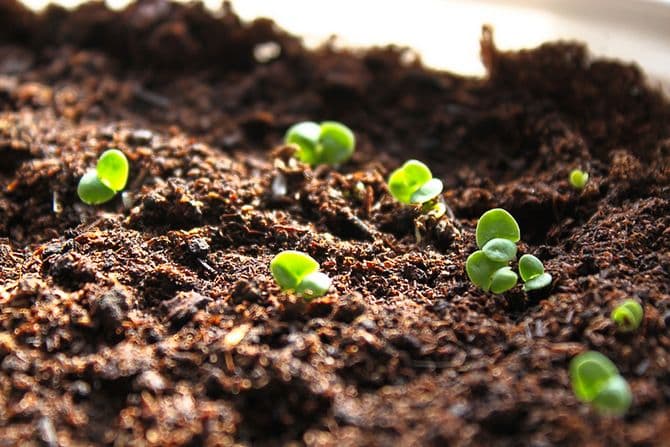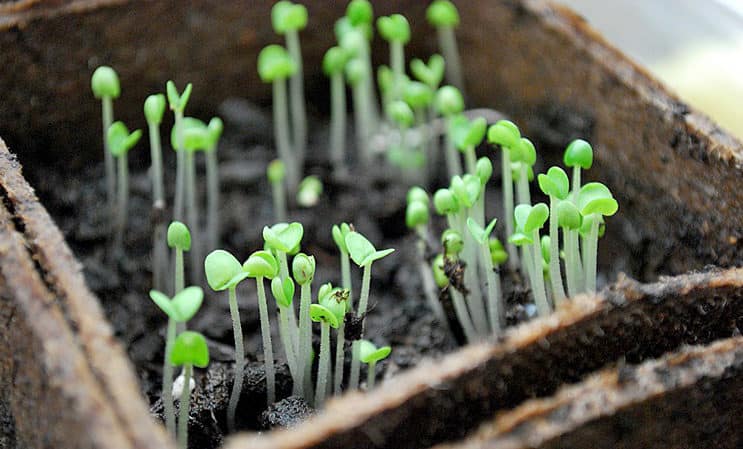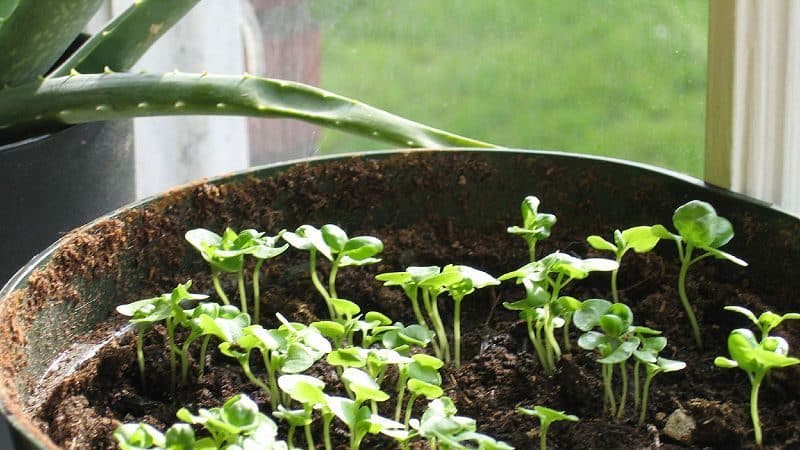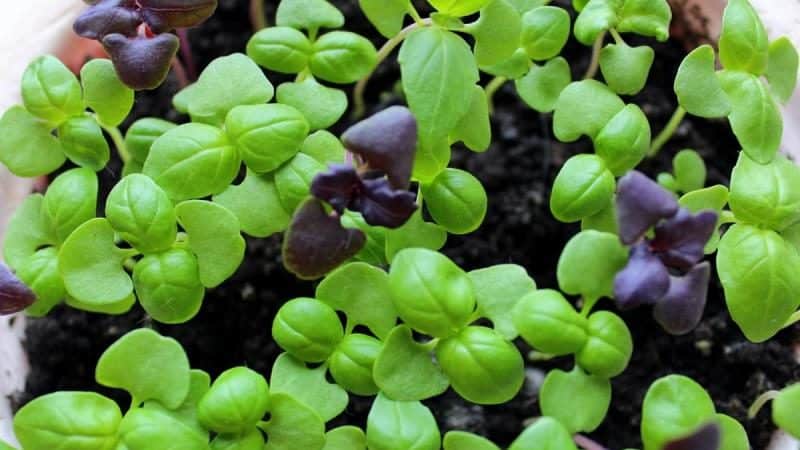How many days after sowing does basil sprout and what should the sprouts look like?
Basil is a tropical plant that loves warmth and moderate humidity. The spice is grown from seeds or seedling method. If you choose the first option, it is important to know when shoots appear, what the seeds should look like, what the shelf life of the seed is, and some other subtleties.
How quickly does basil sprout after sowing?

How many days does it take for seeds to germinate? It depends on the lighting, watering, soil quality and seeding material. At a temperature of +15...+24°C, germination time is 10-14 days, and at +25...+35°C – 7-10 days.
Important! The spice seeds contain essential oils. They prevent the rapid penetration of moisture into the seed and delay the appearance of the first shoots.
To speed up germination, before landing seeds are processed according to the following scheme:
- Warm up to +40°C on a heater or in the sun.
- Lay out the seeds on multi-layer gauze or cotton cloth and cover with it.
- The fabric with the seeds is placed in a container and a little warm (+40°C) water is poured.
- Place in a container in a warm place for 2 days, adding evaporated water 2 times a day at regular intervals.
After a few days in this mode, most of the seeds will have hatched, and they can be planted in open ground or you can work on germination even more by placing them in a cloth soaked in a growth stimulator for an hour.
At home, where it is easy to maintain a stable temperature, optimal humidity and greenhouse effect, by covering the container with glass or film, even without pre-soaking, the first shoots appear on days 5-8.
How does basil sprout?

Basil loves warmth and sun regardless by variety, and is also afraid of strong winds, so it can be grown in:
- in a house or apartment all year round, for example, on a windowsill (in winter - with additional lighting);
- greenhouse, when the weather outside is sunny and the temperature is about +10°C;
- open ground in a sunny, windless area and only when the temperature is at least +15°C.
As seedlings appear, they determine which ones to leave and which ones are better to discard. Signs of a healthy sprout:
- the shoot is elastic and strong;
- the stem is green or lilac, and the leaves are at the initial stage in all varieties green;
- cotyledon leaves have the shape of semicircles and are located in the same plane;
- after 2 weeks, real leaves appear with a shape and color corresponding to the plant variety.
Clumped shoots are thinned out, weak shoots are removed. In order for the plant to produce a bountiful harvest, it is pinched above 6-8 true leaves and inflorescences, if any, are promptly removed.
Seed germination

Seed germination depends on a combination of factors, including:
- Freshness and quality of seed. The shelf life of selected seeds is on average 3-4 years.
- The depth of embedding, which should not exceed 1 cm. The deeper the grains are planted, the more difficult it is for them to break through to the surface.
- Ambient temperature. The warmer it is, the better for the plant.
- Sunny or cloudy weather. For good germination, sunny days should prevail.
- Wind protection.The better the beds are protected from the wind, the better the plants will feel.
- Watering mode. In hot weather, water the soil at the base of the basil at least 2 times a day.
- Plant variety.
- Soil density. In hard soil, it is difficult for seeds to hatch and develop, so the soil must be loose, and the surface crust must be loosened between waterings.
- Soil acidity. The best option is slightly acidic soil.
- Soil saturation with nutrients. A moderate amount of organic fertilizer is required.
If there is an excess of organic fertilizers in the soil, some of them enter our body along with food and negatively affect the condition of the kidneys and liver.
Germination percentage

For basil, the germination rate is considered to be about 60%.
At home, you can check how many seeds will germinate:
- Select a small amount of seeds, place them on a damp cloth, fold it in 2-3 layers and place on a saucer with a small amount of water.
- Cover the top with a saucer or lid of the same size and place it all in a plastic bag.
If you keep such a greenhouse at a temperature of about +20°C, the seeds will hatch in 7-10 days. Then the germination percentage will be easy to calculate.
So, if 6 out of 20 seeds hatch, this is 30%, the minimum threshold at which it is advisable to use the seeds for landing. If the germination percentage is even lower, the batch of seed is rejected.
When sowing, the percentage of germination is taken into account and 2-3 times more seeds are sown to obtain the required number of sprouts.
Attention! Planting basil in the same area for several years in a row is not allowed.
Conclusion
The conditions for growing basil are determined by its natural growing environment.To successfully grow a spice, it is necessary to create conditions close to those familiar to the plant: a lot of heat, sun, sufficient humidity, loose and nutritious soil and calmness. The quality of the seeds and their shelf life.
Knowing the nuances of basil germination, you can achieve the fastest possible appearance of strong shoots and high yields of your favorite spice.